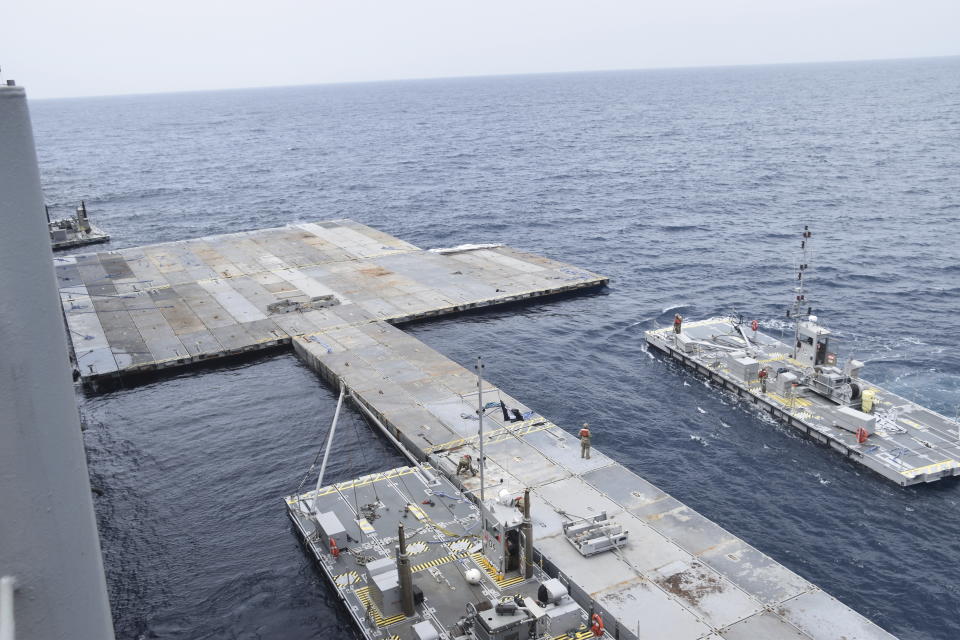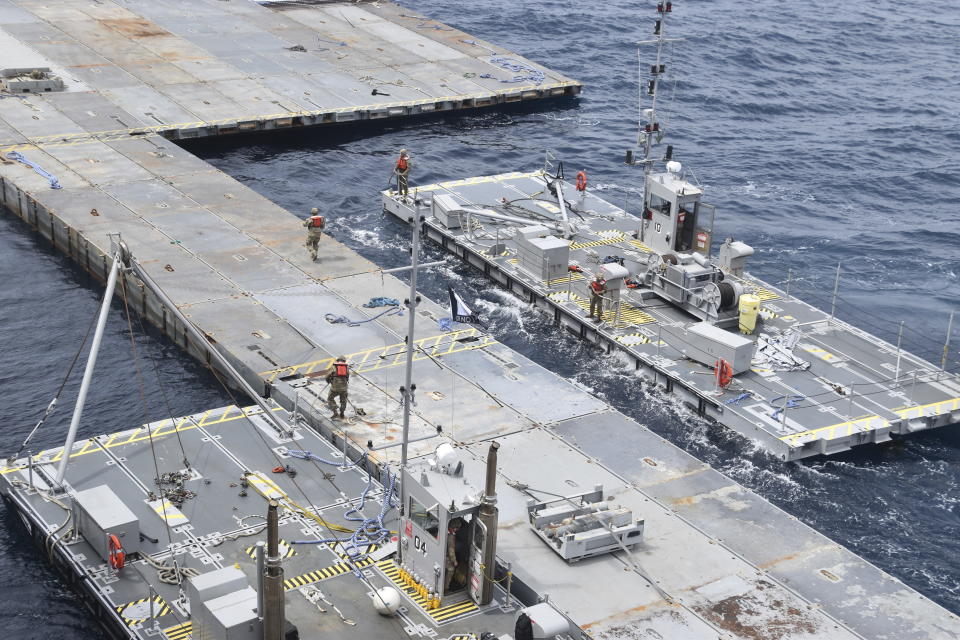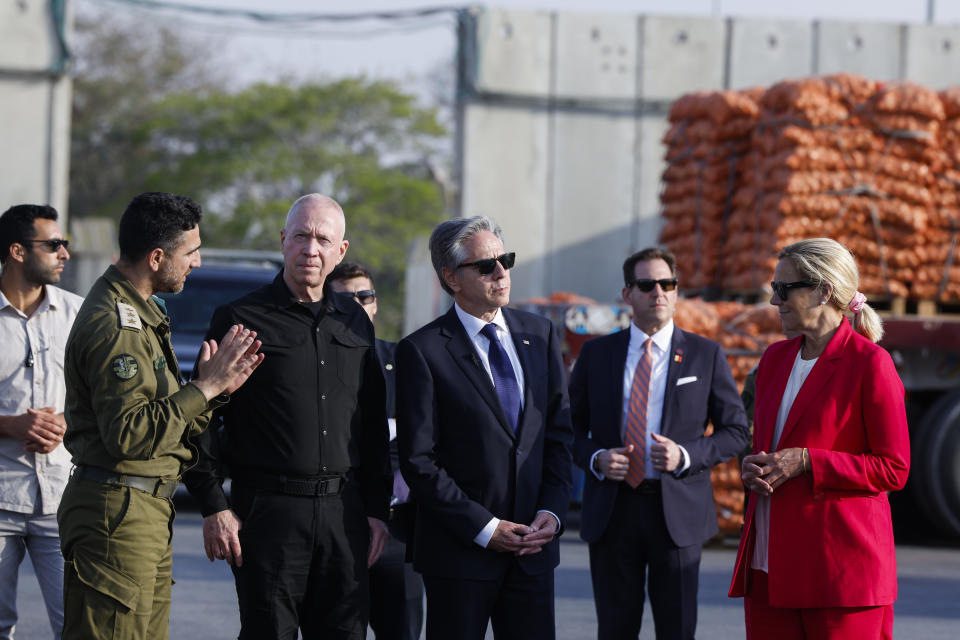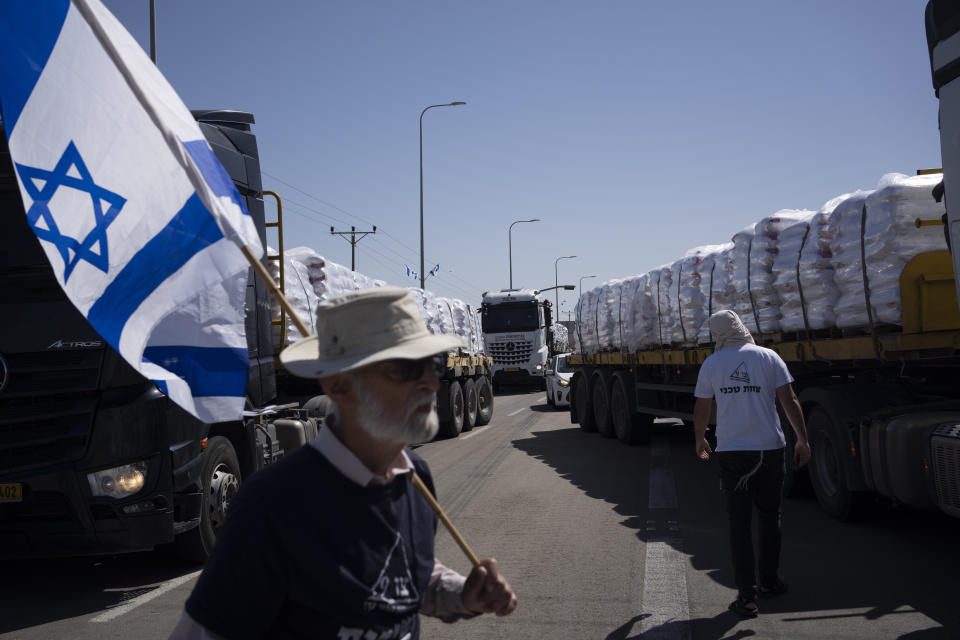The US is wrapping up a pier to bring aid to Gaza by sea. But danger and uncertainty lie ahead
- Oops!Something went wrong.Please try again later.
WASHINGTON (AP) — In the coming days, the U.S. military in the eastern Mediterranean is expected to jab one end of a hulking metal dock — the length of five U.S. football fields — into a beach in northern Gaza.
And that may be the end of the easy part for the Biden administration's two-month-long, $320 million effort to open a sea route to get humanitarian aid into Gaza, with dangers and uncertainties ahead for aid delivery teams as fighting surges and the plight of starving Palestinians grows more dire.
For President Joe Biden, the Pentagon's new floating pier and causeway are a gamble, an attempted workaround to the challenges of getting aid into Gaza from intensifying war and the restrictions its ally Israel has placed at land crossings since Hamas' deadly attacks on Israel launched the conflict in October.
Maj. Gen. Pat Ryder, the Pentagon press secretary, said Tuesday that humanitarian groups were ready for the first shipments through the U.S. maritime route. “In the coming days, you can expect to see this effort underway. And we are confident that that we will be able to, working with our NGO partners, ensure that aid can be delivered,” he said.
Relief groups are watching to see if Israeli officials will allow a freer flow of food and other supplies through this sea route than they have by land and follow through on pledges to protect aid workers. They say protections for humanitarian workers have not improved and point to aid already piling up at Gaza's border crossings, waiting for decisions by Israeli officials to distribute it.
Because land crossings could bring in all the needed aid if Israeli officials allowed, the U.S.-built pier and sea route “is a solution for a problem that doesn't exist,” said Scott Paul, an associate director of the Oxfam humanitarian organization.
“Like all of the land crossings, it comes down to the consent of the government of Israel” on allowing aid through its screening process and ensuring aid teams are safe to distribute it within Gaza, Paul said.
“If Israel is comfortable with allowing the maritime corridor to function ... then it will work in a limited way,” he said this week, as the U.S. military said it was waiting out bad weather to put the pier and dock in place. “And if they don't, it won't. Which is why it's a very, very expensive alternative.”
Ophir Falk, foreign policy adviser to Israeli Prime Minister Benjamin Netanyahu, said Tuesday that the country had enabled the entrance of thousands of aid trucks into Gaza and would continue to do so. It repeated accusations that Hamas was disrupting aid distribution by hijacking and attacking convoys. U.S. State Department spokesman Matthew Miller said this month that there was only one major incident of Hamas commandeering aid trucks.
The Israeli military said in a statement Tuesday that it will keep acting in line with international law to distribute aid to Gaza. It also has previously said there are no limits on aid, it is trying to keep crossings open despite Hamas attacks and has blamed the U.N. for problems with distribution.
With food and aid in short supply in Gaza throughout the war, the head of the U.N. World Food Program and others say that famine has taken hold in northern Gaza and is spreading south.
After an Israeli attack killed seven World Central Kitchen workers on an aid mission on April 1, Israeli Prime Minister Benjamin Netanyahu pledged to Biden to allow in more aid and safeguard those workers.
Last month, truckloads of aid entering Gaza increased by 13%, said Anastasia Moran, an associate director for the International Rescue Committee, a global humanitarian group. But the daily average of trucks entering in April still was about half the average of 500 trucks a day that crossed before the war.
Moran also said Israeli officials have denied permission to roughly two-thirds of aid missions that humanitarian groups have asked to run into northern Gaza, where starvation is the worst.
Now, Israel's military operation in the southern city of Rafah to root out Hamas militants has closed one of Gaza's two main border crossings, while a spate of Hamas attacks has crippled operations at the other crossing, cutting fuel and aid deliveries into Gaza.
It's unclear how much the cutoffs and surge in fighting will affect American-led efforts to deliver food, emergency nutrition for children and other aid to be brought in via the sea route. But humanitarian operations are under threat throughout Gaza, aid officials said.
“The whole aid operation runs on fuel,” said Jeremy Konyndyk, president of Refugees International. “So if fuel is cut off, the aid operation collapses, and it collapses quickly.”
Safety is another essential need for humanitarian workers — and that too is in short supply. Oxfam, Save the Children, the International Rescue Committee and other organizations assert that Israel's government has failed to make the promised changes to protect humanitarian missions within Gaza from Israeli attack.
On Monday, an attack on a U.N. convoy killed an Indian staff member and injured another staffer. The United Nations said Tuesday that the convoy was clearly marked and its planned movements had been announced in advance to Israeli authorities. Israeli officials said they were investigating and denied being told of the convoy's whereabouts.
Around the world, the process of humanitarian workers communicating their planned movements to combatants and getting clearance to move is known as “deconfliction.”
The problem in Gaza, before and after the World Central Kitchen killings, is that Israel has aid teams communicate their plans to the civilian Israeli agency that oversees Palestinian territory, said Paul, the Oxfam official. But unlike the usual operations in other countries, aid teams typically receive no word back from that agency, no assurance that their plans have been passed along to Israeli forces on the ground and no assurances of safety, Paul said.
"There's still not a functioning humanitarian notification system or deconfliction system," said Alexandra Saieh, head of humanitarian policy and advocacy for Save the Children.
Human Rights Watch on Tuesday pointed to eight Israeli strikes on aid group lodgings and convoys whose locations, according to the organizations, had been passed along to Israeli authorities in advance.
The rights group quoted an aid official as saying that without security for these teams, vitally needed goods would pile up undelivered regardless of piers or shipments. Human Rights Watch did not identify the official, citing the person's security.
The U.S. Agency for International Development, which is charged with helping organize and oversee the distribution of aid within Gaza that will be brought in through the U.S. sea route, said it would “continue to press Israel to create the conditions to ensure the safety of humanitarian actors and activities, open additional land crossings, remove impediments to the delivery of humanitarian aid and do far more to prevent the killings” of humanitarian workers and civilians.
The U.N. World Food Program and other humanitarian groups will do the actual delivery of aid from the sea route, USAID said. No U.S. troops will set foot in Gaza. The Israeli military is to handle security on shore, which has been a concern for the United Nations.
The WFP has emphasized the need for neutrality when delivering aid. The sea route can supplement land deliveries but “nothing can compete with truck convoys when it comes to volume of aid,” said Abeer Etefa, a spokeswoman for the organization.
Even if deconfliction problems were solved, teams charged with delivering aid from the sea route would find Gaza a deadly place to operate, said Paul, the Oxfam official. The war has killed more than 35,000 Palestinians, Palestinian health officials say.
“Even a functioning deconfliction system isn't going to work in a free-fire zone,” Paul said.
___
AP reporters Lolita C. Baldor in Washington, Samy Madgy in Cairo and Sam Mednick in Jerusalem contributed.




